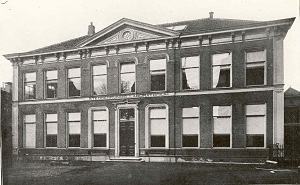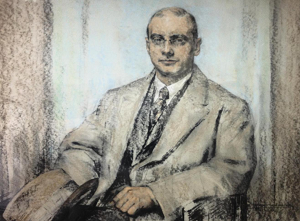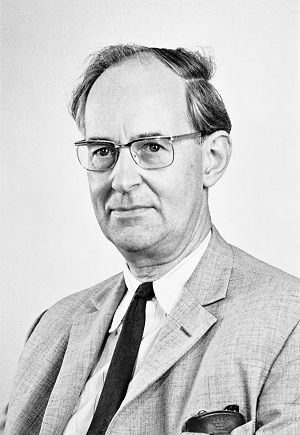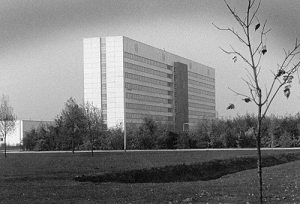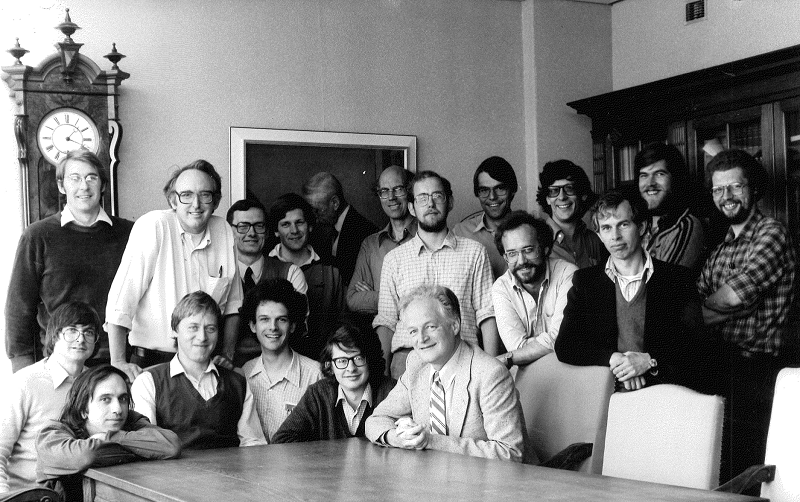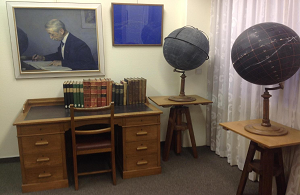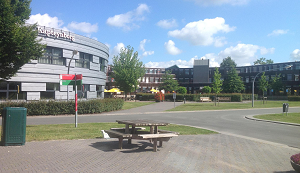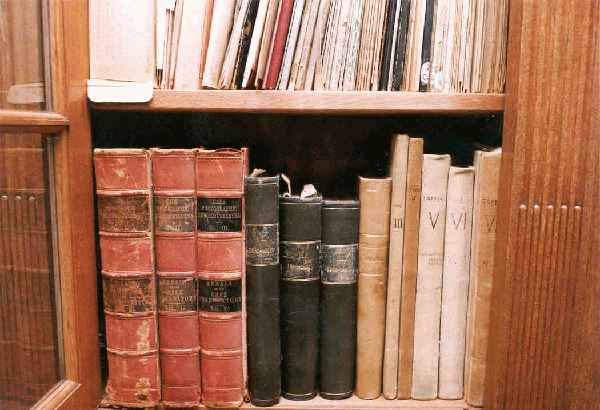De geschiedenis van Kapteyn
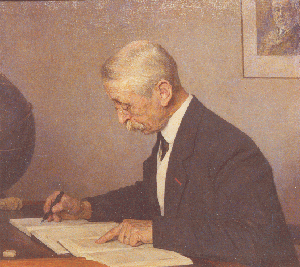
De tijd van Kapteyn
Het Kapteyn Instituut is vernoemd naar de oprichter, Jacobus Cornelius Kapteyn, die leefde van 1851 tot 1922. Kapteyn werd in 1878 benoemd tot hoogleraar astronomie en theoretische mechanica in een tijd dat er in Groningen nog geen astronomische traditie, laat staan een sterrenwacht, bestond.
De leerstoel werd ingesteld als gevolg van de nieuwe wet op het hoger onderwijs van 1876, waarin werd bepaald dat de drie door de overheid gesubsidieerde universiteiten van Groningen, Leiden en Utrecht dezelfde curricula zouden onderwijzen, zodat er in Groningen een nieuwe leerstoel sterrenkunde moest komen. Leiden en Utrecht hadden al zulke leerstoelen en deze werden ondersteund door sterrenwachten. De overheid stelde echter geen geld beschikbaar om er nog een in Groningen te vestigen (en de andere twee hoogleraren sterrenkunde hielden dit samen effectief tegen door negatief advies te geven zodat ze het beschikbare geld niet met een derde partij hoefden te delen).
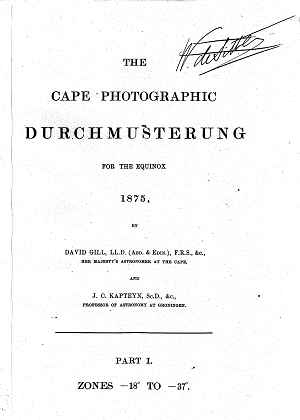
Fotografische platen
In Kaapstad was Sir David Gill was getroffen door de mogelijkheid om sterren te tellen en te catalogiseren op fotografische platen en noemde dit in correspondentie met Kapteyn. Hij had niet de mankracht om sterposities en magnituden (astronomisch jargon voor helderheden) te meten, maar ging toch door met het fotograferen van de zuidelijke hemel.
Uiteindelijk slaagde hij erin Kapteyn over te halen zijn diensten aan te bieden. Kapteyn ging verder met het opmeten van Gill's platen en dit resulteerde na 12 jaar hard werken in de publicatie van de Cape Photographic Durchmusterung in drie delen tussen 1896 en 1900. In deze Durchmusterung zijn de posities en magnituden van 454.875 sterren gecatalogiseerd. Om deze taken uit te voeren richtte Kapteyn een Astronomisch Laboratorium op, een 'Observatorium zonder telescopen', dat uiteindelijk naar hem werd vernoemd.
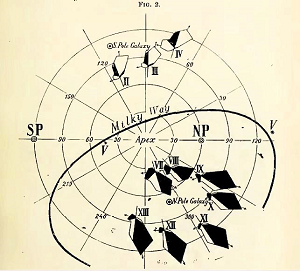
'Sterrenstromen'
Kapteyn was vooral geïnteresseerd in de structuur van het 'siderische systeem'. Maar hiervoor moesten afstanden van sterren worden gemeten. Directe metingen van de weerkaatsing aan de hemel van de beweging van de aarde rond de zon zijn echter alleen mogelijk voor de dichtstbijzijnde sterren. Hij ontwierp een nieuwe, statistische methode, de zogenaamde seculaire parallaxmetingen, om de afstanden van sterren statistisch te schatten, gebruikmakend van het feit dat de verplaatsing van een ster aan de hemel als gevolg van de beweging van de Zon door de ruimte afneemt met de afstand.
Deze verplaatsingen aan de hemel, die eigenbeweging worden genoemd, bevatten natuurlijk ook een component door de eigen beweging van de ster in de ruimte en kunnen daarom alleen statistisch worden toegepast. Dit vereist dat de eigenbeweging van sterren in de ruimte willekeurig en isotroop (zonder voorkeursrichtingen) is. Kapteyns eerste grote ontdekking was dat dit in feite niet waar is, maar dat er blijkbaar twee 'sterrenstromen' zijn, wat hij in 1904 bekendmaakte op de St. Louis International Exposition. Hij ontdekte dat de ruimtebewegingen van 'gewone' sterren in de buurt van de zon twee voorkeursrichtingen vertoonden; later werd dit door Karl Schwarzschild verklaard als het resultaat van een anisotropie van stellaire bewegingen in een snelheidsellipsoïde met ongelijke assen. De stromen zijn dan de tegengestelde richtingen waarin de willekeurige bewegingen het grootst zijn.
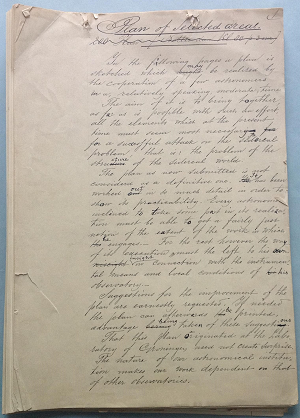
Ruimteverdeling van sterren
Kapteyn ontwikkelde methoden om de ruimteverdeling van sterren af te leiden uit stertellingen als functie van de magnitude (helderheid) langs de hele hemel en het in kaart brengen van de schijnbare verplaatsingen, eigenbewegingen genoemd, van sterren als gevolg van hun beweging in de ruimte ten opzichte van de zon.
Absorptie van sterlicht
Hij maakte zich veel zorgen over de absorptie van sterlicht door interstellair materiaal en publiceerde hierover twee artikelen in het Astrophysical Journal in 1909. Uiteindelijk concludeerde hij dat er inderdaad bewijs was voor dergelijke absorptie. Hij had zich terecht gerealiseerd dat absorptie (in de praktijk vooral verstrooiing van licht door kleine stofdeeltjes) afhankelijk zou zijn van de golflengte, waardoor sterren op grote afstanden roder zouden lijken.
In feite valt zijn afgeleide hoeveelheid, verbeterd in het proefschrift van zijn student Pieter van Rhijn, reuze mee, hoewel nu bekend is dat deze beperkt is tot dicht bij het vlak van het Melkwegstelsel. Later toonde Harlow Shapley in de VS aan dat absorptie in de richting van een bolvormige sterrenhoop buiten de Melkweg vrijwel afwezig was, in ieder geval aanzienlijk minder dan de waarde van Kapteyn. Dit leidde ertoe dat astronomen, inclusief Kapteyn, ten onrechte Shapley volgden en interstellaire absorptie overal negeerden, ook in de buurt van de Melkweg, in de 'schijf' van het Melkwegstelsel.
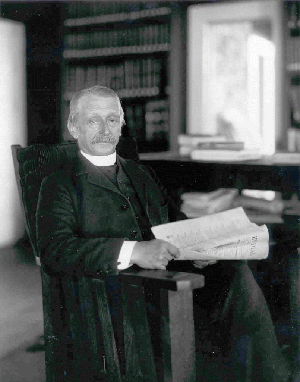
Internationale samenwerking
Kapteyn was ook een pionier op het gebied van internationale samenwerking en was daar zeer succesvol in; de noodzaak voor hem om te werken met platen, genomen door anderen en gemeten in zijn observatorium zonder telescoop, en zijn Angelsaksische oriëntatie (in tegenstelling tot de Duitse oriëntatie die zo gebruikelijk was in die tijd) moeten hierbij belangrijke factoren zijn geweest.
George Ellery Hale
Hij werd een goede vriend van George Ellery Hale en bracht tussen 1908 en 1914 zijn zomermaanden door als onderzoeksmedewerker op het Mount Wilson Observatory in Californië. In 1906 publiceerde hij zijn Plan of Selected Areas, waarin observatoria over de hele wereld posities, magnituden, eigenbewegingen (en voor het helderste deel ook spectraalsoorten en radiale snelheden) zouden meten in een aantal zorgvuldig gekozen velden verspreid over de hele hemel.
George Ellery Hale was zo onder de indruk van Kapteyn dat, toen hij in 1906 bezig was met de bouw van de grootste telescoop ter wereld (de 60 inch op Mount Wilson bij Pasadena en Los Angeles), hij Kapteyns plan aannam als het belangrijkste waarnemingsprogramma voor zijn nieuwe extreem grote telescoop. Dit resulteerde ook in een uitnodiging aan Kapteyn om onderzoeksmedewerker te worden van het Carnegie Institution of Washington bij het Mount Wilson Observatory in Californië om toezicht te houden op dit werk. Vanaf de tweede keer bracht Kapteyn, vergezeld van zijn vrouw, zijn zomermaanden door in Californië vanaf 1908 tot 1914, toen de 'Grote Oorlog' reizen over de Atlantische Oceaan onmogelijk maakte.
'Astronomisch laboratorium'
Kapteyn is er nooit in geslaagd een sterrenwacht in Groningen te vestigen. Wel verzekerde hij zich van een gebouw voor zijn 'Astronomisch Laboratorium', dat in 1896 op een tijdelijke locatie werd geopend en na enkele verhuizingen in 1913 zijn definitieve locatie kreeg (in de Broerstraat in het centrum van Groningen naast het centrale gebouw van de universiteit). Na Kapteyns pensionering in 1921 en kort voor zijn dood in 1922 besloten de curatoren van de Rijksuniversiteit Groningen het astronomisch laboratorium naar hem te vernoemen.
Tegen het einde van zijn leven publiceerde Kapteyn samen met Pieter van Rhijn een schematisch model voor de verdeling van sterren in de ruimte (Astrophysical Journal, 1920), gevolgd door zijn 'First attempt at a theory of the arrangement and motion of the Sidereal System' (Astrophysical Journal, 1922). Hierin legde hij de basis voor dynamische studies door waargenomen ruimteverdelingen te combineren met bewegingen en leidde hij een eerste waarde af voor de dichtheid van materie in de buurt van de zon.
Kapteyn Universum
Dit Kapteyn Universum, een sterk afgeplat systeem met de Zon redelijk dicht bij het centrum, leed in de richting van het vlak onder absorptie maar is in de verticale richting zelfs nu nog heel dicht bij wat we nu denken dat het is. Door het verwaarlozen van absorptie is het Kapteyn Heelal in de lengterichting ongeveer drie keer te klein vergeleken met wat we nu de 'schijf' van het Melkwegstelsel noemen. Shapley had gevonden dat bolvormige sterrenhopen verdeeld waren in een ruwweg bolvormige structuur, geconcentreerd naar een centrum in het vlak van de Melkweg, maar dit was veel groter dan Kapteyns heelal. Dit is nu de 'halo' van de Melkweg, maar mede door absorptie is Shapley's stelsel een factor twee te groot.

Interstellaire absorptie
Kapteyn is nu internationaal minder prominent, tot op zekere hoogte omdat zijn werk aan de structuur van de Melkweg in de VS meestal wordt gezien als een wedstrijd tussen hem en Shapley die door de laatste werd gewonnen.
Beschreven was dat Kapteyn een kapitale blunder had begaan door interstellaire absorptie te negeren, terwijl dit in feite werd ingegeven door Shapley. Een andere belangrijke reden is dat Kapteyn na de oorlog het standpunt innam dat het een grote vergissing was om Duitsland en andere verslagen naties uit te sluiten van internationale organisaties zoals de Volkenbond, de Internationale Onderzoeksraad en de Internationale Astronomische Unie, een standpunt waarvoor hij zwaar werd bekritiseerd en veroordeeld door veel wetenschappers en astronomen in het Verenigd Koninkrijk en de Verenigde Staten in het bijzonder.
Van Rhijn en Blaauw
In 1921 werd Kapteyn als hoogleraar sterrenkunde en directeur van het sterrenkundig laboratorium opgevolgd door zijn assistent Pieter J. van Rhijn (1886-1960). Deze was in 1915 bij Kapteyn gepromoveerd. Kapteyns eerste student, Willem de Sitter (1872-1932; promotie in 1901) was directeur van de Sterrewacht Leiden geworden.
Jan Hendrik Oort
Kapteyns beroemdste student was Jan Hendrik Oort (1900-1992), die vanwege Kapteyn naar Groningen was gekomen om te studeren. Hij twijfelde tussen natuurkunde en sterrenkunde en heeft herhaaldelijk verklaard dat hij door Kapteyn tot de sterrenkunde was bekeerd. Hij werkte onder Kapteyn aan high velocity sterren, wat hem later op het ontdekkingsspoor van de galactische rotatie zou brengen, maar moest in 1922 nog aan scriptieonderzoek beginnen. De Sitter bood hem een baan aan in Leiden en na twee jaar op Yale te hebben gewerkt onder Frank Schlessinger verhuisde hij naar Leiden. Uiteindelijk promoveerde hij in Groningen bij van Rhijn in 1926 op het onderwerp waar hij in zijn Groningse jaren al aan had gewerkt. Andere studenten van van Rhijn, zoals Peter van de Kamp (1901-1994; gepromoveerd in 1926) en Barthelomeus (Bart) Jan Bok (1906-1983; gepromoveerd in 1932) verhuisden naar de VS, waar een baan in de sterrenkunde makkelijker te krijgen was dan in Nederland. Adriaan Blaauw (1916-2010) was uit Leiden gekomen om met van Rhijn samen te werken en werkte tijdens de Tweede Wereldoorlog in Groningen. Hij promoveerde uiteindelijk in 1946, maar ging terug naar Leiden (Blaauw keerde uiteindelijk terug).
Telescoop voor het Laboratorium
Van Rhijns pogingen om met geld van de overheid een telescoop voor het Laboratorium te krijgen mislukten. In 1931 slaagde hij er wel in om een 55 cm reflector en een koepel op het laboratoriumgebouw te krijgen, gefinancierd met privégeld. Deze telescoop werd voornamelijk gebruikt door van Rhijn en Jan Borgman voor studies naar interstellaire roodheid. In 1959 werd de telescoop verwijderd vanwege structurele problemen met het gebouw.
Het werk onder Van Rhijn tijdens zijn lange ambtstermijn als hoogleraar en directeur (1921 tot 1957) betrof de verdere uitvoering van het Plan van Uitgekozen Gebieden. Het was niet erg vernieuwend, maar tijdrovend en routinewerk en het Kapteyn Laboratorium verloor veel van zijn bekendheid. Het meeste werk ging naar het bepalen van de spectra van sterren in deze gebieden; in samenwerking met de Bergedorfer Sternwarte bij Hamburg werden prisma-objectieve platen geanalyseerd in alle gebieden op het noordelijk halfrond, wat resulteerde in de Bergedorfer Spektral-Durchmusterung der 115 nordlichen Kapteynschen Eichfelder, voltooid in 1953. Blaauw heeft later vaak geklaagd dat Groningen in de titel had moeten staan omdat een aanzienlijk deel van het werk daar werd uitgevoerd. Ontegenzeggelijk ging het Laboratorium Kapteyn tijdens de jaren van Rhijn hard achteruit.
Adriaan Blaauw
In 1957, na de pensionering van van Rhijn, werd Adriaan Blaauw benoemd tot hoogleraar en directeur. Onder zijn leiding verbreedde het onderzoek zich naar verschillende andere gebieden. En Blaauw was zeer betrokken bij de oprichting van de European Southern Observatory ESO, een initiatief van Oort in Leiden en Walter Baade, een Duitser die het grootste deel van zijn leven werkte bij Mount Wilson en Palomar Observatories. Na het eerste symposium van de Internationale Astronomische Unie over Galactisch Onderzoek, gehouden bij Groningen in 1953, werd staflid Lukas Plaut aangewezen om de Palomar-Groningen Survey van RR Lyrea sterren uit te voeren in een van 'Baade's Windows' in de richting van het Galactisch Centrum, die duurde tot het begin van de jaren 1970. Jan Borgman vergemakkelijkte dat door een instrument te ontwerpen en te bouwen dat sterrenvelden elektronisch kon vergelijken, zodat variabele sterren gemakkelijk konden worden herkend (een geautomatiseerde versie van een zogenaamde Blink Comparator die visueel werd gebruikt). Stuart R. Pottasch werd in 1963 benoemd tot hoogleraar astrofysica.
Jan Borgman
Onder Jan Borgman werd in 1965 de Kapteyn Sterrenwacht in Roden geopend met een 61-cm reflector. Borgman startte ook een werkgroep 'fotometrie' voor ruimteonderzoek, die eerst gebruik maakte van ballonnen maar uiteindelijk uitmondde in een sterke betrokkenheid bij de Astronomische Nederlandse Satelliet (ANS; een ultraviolet en röntgen ruimteobservatorium), die tussen 1974 en 1976 in een baan om de aarde werd gebruikt. De Kapteyn Sterrewacht bleef sterk betrokken bij de vroege ontwikkeling van de ESO, uiteindelijk gevestigd in Chili na veel testen in Zuid-Afrika. Galactische structuur bleef een centraal interessegebied. Onder Hugo van Woerden werd een groep opgericht om de 25-meter radiotelescoop in Dwingeloo te gebruiken voor studies van het neutrale waterstofgas in het Melkwegstelsel, een initiatief dat voortkwam uit en sterk gesteund werd door Blaauw.
Na 1970
In 1968 werd Blaauw parttime wetenschappelijk directeur van ESO en in 1970 directeur-generaal. Ook in 1970 verhuisde het Kapteyn Laboratorium naar een nieuwe locatie op het in ontwikkeling zijnde campusterrein bij de noordelijke buitenwijk Paddepoel van Groningen (nu de Zernike Campus). De werkgroep voor ruimteonderzoek, nu Laboratorium voor Ruimteonderzoek, verhuisde ook van Roden naar Paddepoel.
Het oorspronkelijke Kapteyn Laboratorium werd enige tijd gebruikt als onderdeel van het centrale bestuurskantoor van de universiteit, maar raakte in de jaren tachtig beschadigd door een brand. Het universiteitsbestuur greep de gelegenheid aan om het gebouw te slopen. Rond dezelfde tijd vond een herstructurering van de organisatiestructuur van universiteiten plaats, aangewakkerd door studentenopstanden die meer betrokkenheid en invloed op beslissingen eisten in democratische procedures, waarbij astronomie een subfaculteit werd. Stuart R. Pottasch werd de eerste decaan van de subfaculteit Astronomie (later voorzitter van de afdeling Astronomie) van 1970 tot 1982.
Westerbork Synthese Radio Telescoop
In 1970 werd ook de Westerbork Synthese Radio Telescoop in gebruik genomen en de radiogroep van het Kapteyn Instituut werd al snel een van de belangrijkste gebruikers. Vooral nadat waarnemingen met de 21-cm lijn van neutraal waterstof mogelijk werden (voor een groot deel het resultaat van de inspanningen van Ronald J. Allen, die als postdoc was aangenomen en vervolgens staflid werd), werden uitgebreide studies gemaakt van nabije sterrenstelsels, waarbij de nadruk verschoof van structuur van ons eigen Melkwegstelsel naar die van externe stelsels.
Stervorming, interstellair medium en gas in het Melkwegstelsel bleven een tweede belangrijk aandachtspunt. Vooral de zogenaamde vlakke rotatiecurves van spiraalstelsels en het bewijs dat deze grote hoeveelheden onbekende 'donkere materie' bevatten, werden een belangrijk onderwerp van studie. Renzo Sancisi en Miller Goss, naast Ron Allen, Tjeerd van Albada en Ron Ekers, leidden de Westerbork-studies, terwijl Pieter C. van der Kruit radiostudies combineerde met het nieuwe veld van optische oppervlaktefotometrie op basis van het elektronisch scannen en digitaliseren van fotografische platen met de Astrocan-machine van de Sterrewacht Leiden.
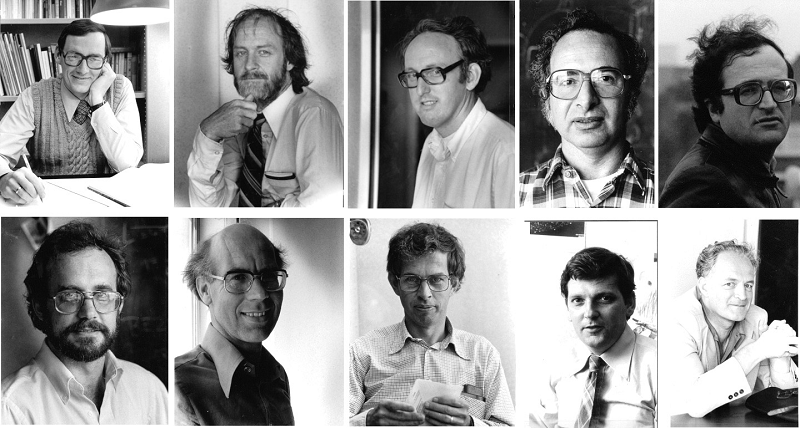
Space Research groep
De Space Research groep, inmiddels onder leiding van Reinder J. van Duinen, leverde een belangrijke bijdrage aan de Astronomical Netherlands Satellite (ANS), gevolgd door een grote deelname aan de NL/UK/NASA Infra-Red Astronomical Satellite IRAS, die in 1983 werd gelanceerd.
Borgman was in 1975 decaan geworden van de Faculteit Wiskunde en Natuurwetenschappen, werd vervolgens Rector Magnificus en vervolgens voorzitter van het College van Bestuur van de Rijksuniversiteit Groningen, en verhuisde in 1988 naar Den Haag om voorzitter te worden van de Nederlandse Organisatie voor Wetenschappelijk Onderzoek (NWO). Het laboratorium voor Ruimteonderzoek werd onderdeel van de Nederlandse Stichting voor Ruimteonderzoek (SRON), gefinancierd door NWO.
Interuniversitaire Werkgroep voor Astronomische Instrumentatie
In 1981, met het begin van de Nederlandse betrokkenheid bij de UK/NL Isaac Newton Groep van optische telescopen op La Palma (Canarische Eilanden), werd in Roden de Interuniversitaire Werkgroep voor Astronomische Instrumentatie opgericht met personeel van de universiteiten van Groningen en Leiden. Onder leiding van Harvey R. Butcher en Jan Willem Pel ontwikkelde deze werkgroep instrumentatie voor zowel ESO als La Palma. De Werkgroep werd in 1995 overgeplaatst naar de Radiosterrenwacht in Dwingeloo en maakte naam met het ontwerpen en bouwen van optische instrumentatie; de Kapteyn Sterrewacht in Roden werd gesloten. In 1983 verhuisde het Kapteyn Sterrenkundig Instituut naar de huidige locatie in wat eerst het Zernikegebouw heette, nu de Kapteynborg.
Erkenning afdeling sterrenkunde
In 1982 werd Pottasch opgevolgd door Ronald J. Allen als voorzitter van de afdeling Sterrenkunde en deze positie werd vervolgens bekleed door Hugo van Woerden van 1985 tot 1991 en door Pieter C. van der Kruit van 1991 tot 1994. In 1994 werd van der Kruit decaan van de Faculteit Wiskunde en Natuurwetenschappen tot eind 1997. Ook in 1994 werd de afdeling Sterrenkunde (die het Kapteyn Laboratorium in Groningen, de Kapteyn Sterrenwacht in Roden en het bijbehorende onderzoek binnen de afdeling Ruimteonderzoek omvatte) formeel erkend door de Rijksuniversiteit Groningen als een onderzoeksinstituut, waardoor het een zekere beschermde status kreeg, en werd omgedoopt tot het Kapteyn Sterrenkundig Instituut. Tjeerd S. van Albada werd wetenschappelijk directeur, in 1998 opgevolgd door Piet van der Kruit.
NOVA
In 1992 vormden de sterrenkundige instituten aan de Nederlandse universiteiten samen de Nederlandse Onderzoekschool voor Astronomie (NOVA) en werden als zodanig erkend door de Koninklijke Nederlandse Akademie van Wetenschappen. In 1998 organiseerde de minister van Onderwijs, Cultuur en Wetenschap een 'Dieptestrategie', waarin de meer dan 100 onderzoeksscholen in Nederland konden meedingen naar erkenning als toponderzoeksschool en aanzienlijke aanvullende financiering konden krijgen voor een periode van tien jaar.
NOVA kwam als nummer één uit de bus in deze landelijke competitie, waarin slechts zes scholen de status van toponderzoekschool kregen. Dit is sinds een jaar of tien verlengd, waarbij ASTRON het predicaat 'voorbeeldig' kreeg, een onderscheiding die gedeeld wordt met slechts één andere onderzoeksschool in Nederland.
Uitbreiding en vernieuwing wetenschappelijke staf
Als gevolg van extra middelen en de beschermde status van NOVA, alsmede de verhuizing van de optische werkplaatsen naar Dwingeloo, pensioneringen en vertrek van personeel naar andere grote instellingen in het buitenland, vond er tussen ruwweg 1990 en 2010 een aanzienlijke uitbreiding en vernieuwing van de wetenschappelijke staf in Groningen plaats. In 2025 zijn er ongeveer 20 vaste wetenschappelijke medewerkers, ongeveer 15 postdocs, 45-55 promovendi en een groep ondersteunend technisch, computer- en administratief personeel.
Wetenschappelijk directeuren Kapteyn Instituut
De wetenschappelijk directeuren waren Thijs (J.M.) van der Hulst (2005-2011), Reynier F. Peletier (2011-2017), Scott C. Trager (2017-2020), Léon Koopmans (2020-2025) en Inga Kamp (2025 - heden).
In 2017 veranderde de Faculteit der Wis- en Natuurwetenschappen haar naam in de Faculteit Natuurwetenschappen. De staf van het Kapteyn Astronomisch Instituut was of is nauw betrokken bij vele grond- en ruimtefaciliteiten, zoals ESO, La Palma, ISO, Herschel, LOFAR, SKA, Euclid en vele andere. Ze zijn buitengewoon succesvol geweest in het verkrijgen van externe financiering, naast NOVA, en prijzen en onderscheidingen. Hieronder vallen subsidies van NWO en persoonlijke subsidies zoals Veni, Vidi en Vici van NWO en starting, consolidating en advanced grants van de European Research Council ERC.
Piet van der Kruit is benoemd tot een van de weinige eminente hoogleraren in de Faculteit (Jacobus C. Kapteyn Hoogleraar). Prof. Amina Helmi is onderscheiden met de zeer prestigieuze Spinozaprijs, de hoogste wetenschappelijke onderscheiding in Nederland.
Literatuur
- Kapteyn, zijn Leven en Werken , 1928, biography of Kapteyn by his daughter Henrietta Herzsprung-Kapteyn. Translated into English by P.C. van der Kruit op https://www.astro.rug.nl/JCKapteyn/.
- In het voetspoor van Kapteyn: Schetsen uit het werkprogramma van de Nederlandse Sterrenkundigen aangeboden door vrienden en collega's aan Prof. dr. P.J. van Rhijn ter gelegenheid van zijn zeventigste verjaardag, 1956, Nederlandse Astronomen Club.
- Sterrenkijken Bekeken; Sterrenkunde aan de Groningse Universiteit vanaf 1614 , 1983, publication of the Groningen University Museum (eds. A. Blaauw, J.A. de Boer, E. Dekker and J. Schuller tot Peursum-Meijer).
- The Legacy of J.C. Kapteyn; Studies on Kapteyn and the Development of Modern Astronomy , 2000, proceedings of a symposium on Kapteyn (eds. P.C. van der Kruit and K. van Berkel), published by Kluwer Academic Publishers (ISBN 978-3-319-10875-9).
- Jacobus Cornelius Kapteyn: Born investigator of the Heavens, 2014, by Pieter C. van der Kruit, volume 416 in the Astrophysics and Space Science Library of Springer Publishers (ISBN 978-3-319-10875-9).
- De Inrichting van de Hemel: Een biografie van astronoom Jacobus C. Kapteyn, 2016, by Pieter C. van der Kruit, Amsterdam University Press (ISBN 978-9-462-98042-6).
- Pioneer of Galactic Astronomy: A Biography of Jacobus C. Kapteyn, 2020, by Pieter C. van der Kruit, Springer Biographies, Springer Publishers (ISBN 978-3-030-55422-4).

